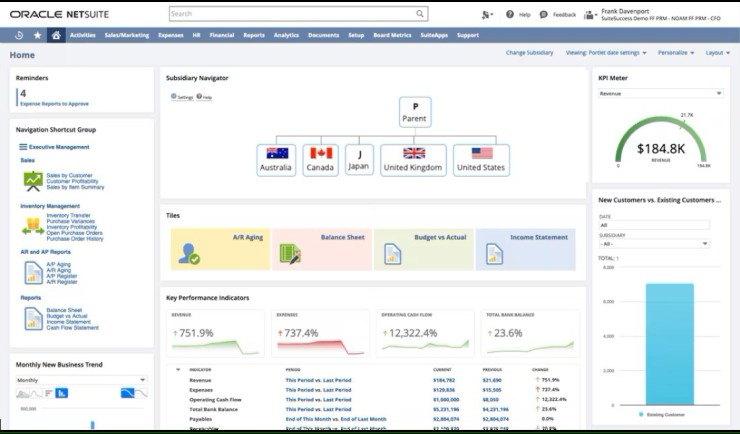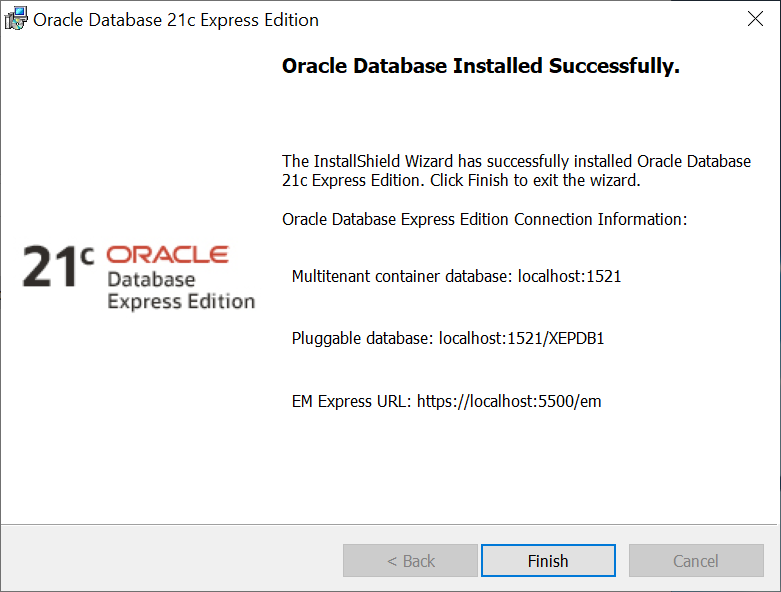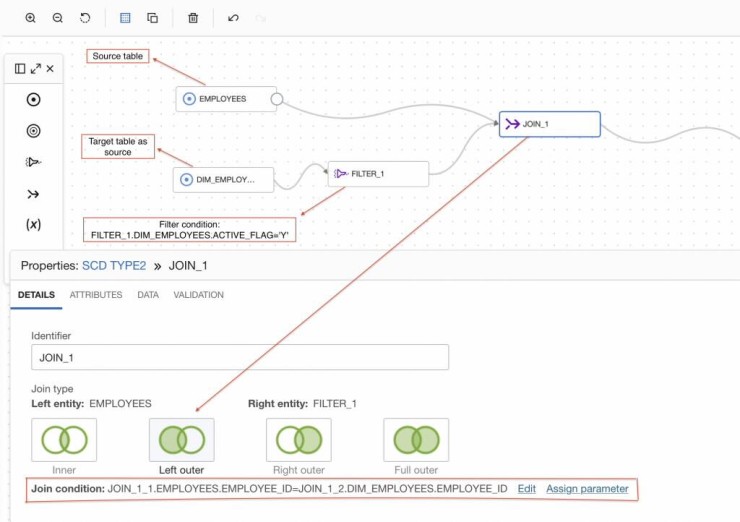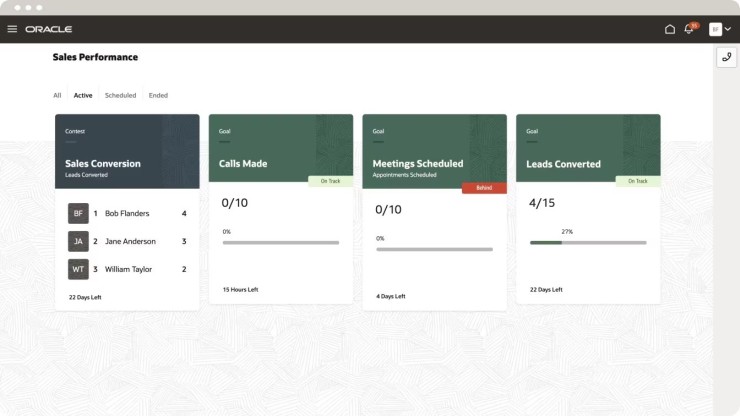
NetSuite ERP is a cloud-based business management platform designed to unify critical processes for medium and large organizations. It includes modules for financial management, accounting, resource planning, inventory, sales, purchasing, CRM, and human resources. Its multi-entity architecture allows managing multiple subsidiaries, currencies, and tax regulations from a single system without requiring separate instances. Updates are automatic and continuous, avoiding prolonged service interruptions.
NetSuite ERP is aimed at environments that require scalability and flexibility, offering real-time reporting tools, customizable dashboards, and configurable workflows to automate approvals and internal processes. Thanks to its SaaS approach, users access the platform via web browsers or mobile devices, without relying on local infrastructure. Additionally, it features a robust ecosystem of REST APIs and connectors that simplify integration with third-party applications such as e-commerce platforms, Business Intelligence tools, and payroll systems.
NetSuite ERP Features
NetSuite ERP provides a complete suite of business modules ranging from finance to project management and CRM. Fully cloud-based, it streamlines cash flow, inventory, and sales management, and facilitates collaboration across subsidiaries, reducing implementation times. Its modular design allows enabling or disabling components according to business needs, avoiding inactive licenses that increase costs.
Architecture and Technology
NetSuite ERP runs on a multi-tenant infrastructure hosted in Oracle's own data centers. Each client operates in a secure, isolated instance, preventing user interference. JavaScript and SuiteScript enable system customization without altering the core. It uses Oracle databases in distributed clusters, ensuring high availability and data replication across continents.
User Interface and Experience
The web interface offers role-based dashboards, where each user views KPIs relevant to their function: CFOs, warehouse managers, or sales reps. Dashboards feature interactive charts, task lists, and approval alerts. On mobile devices, the native app (iOS and Android) enables expense approvals, report reviews, and work order management without constant connectivity, syncing data once the connection is restored.
Implementation and Customization
No servers are required: once the service is acquired, a guided setup assistant configures company structures, currencies, and accounting cycles. For customizations, NetSuite offers SuiteBuilder, allowing screen modifications, custom fields, and workflow redesigns via drag-and-drop, without advanced programming knowledge. It also includes SuiteFlow, a workflow engine for automating approvals of budgets, orders, and invoices. SuiteScript 2.x enables advanced client- and server-side scripting for integration and business-specific validation.
Integration and Interoperability
NetSuite ERP provides REST and SOAP APIs for integration with external applications. Official connectors exist for marketplaces (Shopify, Magento), complementary CRMs (Salesforce), BI tools (Oracle Analytics, Power BI), and payroll systems (ADP, Ceridian). Through SuiteTalk, ETL processes can be automated to sync with data warehouses and generate consolidated reports. Third-party integration without altering core code enables ecosystems including IoT and advanced analytics tools.
Security and Regulatory Compliance
The platform provides role-based access controls (RBAC), allowing precise permission settings at field and record levels. Authentication can be enhanced with 2FA and SSO via providers like Okta or Azure AD. Data is protected with TLS encryption in transit and AES at rest. NetSuite ensures compliance with regulations (GDPR, SOX, PCI DSS), maintaining detailed audit logs for every transaction, including record changes and user access.
NetSuite Functionalities
Financial Module
The financial module includes tools for general ledger, accounts payable and receivable, bank reconciliation, and advanced financial reporting. Automatic data consolidation improves accuracy in closing and budget control. With a unified database, accounting operations are directly linked to inventory and billing areas, reducing manual errors and accelerating report generation.
Inventory Module
The inventory module offers real-time stock tracking, including batch and serial number management. Auto-reorder algorithms and configurable alerts help maintain optimal stock levels, reduce costs, and avoid obsolescence or stockouts. Integration with supply chain management ensures synchronized data across warehouses and distribution points, boosting operational efficiency.
Order and Billing Management
The order and billing management functionality covers the entire sales cycle. The system automates key processes such as order validation, invoice generation, and return tracking, reducing cycle times and increasing revenue accuracy. This automation is key to accelerating cash flow and optimizing administrative resources.
Supply Chain
Supply chain coordination is enhanced through modules for planning, procurement, and logistics. Features include delivery tracking, route planning, and integration with external suppliers’ systems, enabling effective synchronization between supply and demand. This connectivity strengthens responsiveness to market changes and ensures agile execution.
CRM
CRM integration allows detailed tracking of customers and sales opportunities. It supports full relationship management, customer segmentation, and behavior analysis, backing personalized marketing strategies that enhance loyalty. CRM data is shared across modules, offering a comprehensive view for strategic, data-driven decisions.
Business Intelligence
Business Intelligence (BI) and analytics are powered by customizable dashboards and real-time reports. These tools help leaders assess performance, detect trends, and adjust strategies quickly. The intuitive interface and customizable alerts and metrics support proactive monitoring of key business indicators.
Human Resources
The platform also includes human resources and professional services modules, covering payroll, performance tracking, and project planning and monitoring. Integrating these functions aligns human talent with corporate goals and optimizes resource allocation according to operational demand.
Security
Information security is enhanced through automatic updates and regulatory compliance protocols, ensuring a controlled environment resilient to external threats. The platform’s adaptability and scalability allow new modules and functions to be added as the business grows or evolves, preparing it for digital transformation challenges.
Strengths and Weaknesses
| Strengths | Weaknesses |
|---|---|
| 100% Cloud-based: automatic updates without service interruptions, access from any device, no need for local infrastructure. | High initial cost: monthly fee varies depending on modules and number of users; costs may exceed other SaaS solutions with extensive customization needs. |
| Full module suite: finance, manufacturing, CRM, e-commerce, PSA, and HR in one platform, avoiding complex third-party integrations. | Learning curve: various components and SuiteScript flexibility require specialized training; new users may feel overwhelmed at first. |
| Multi-company scalability: OneWorld supports managing multiple divisions, currencies, and tax rules in a single environment with real-time consolidation. | Connection dependency: as a fully online ERP, internet outages or slow speeds directly affect productivity. |
| No-code customization: SuiteBuilder and SuiteFlow enable UI and process adaptation without programming, reducing reliance on custom development. | Advanced customization limitations: although SuiteScript extends capabilities, highly specific processes or complex migrations may require external consultants, increasing project costs. |
| Extensive partner ecosystem: certified partners offer integrations with marketplaces, BI tools, and consulting services, speeding up deployments and continuous improvements. | Complex licensing: the structure (per user, per module, with OneWorld) requires careful planning to optimize costs and avoid unused components. |
| Integrated analytics and reporting: SuiteAnalytics delivers ad hoc reports and advanced dashboards, enabling real-time, data-driven decision-making. | Industry-specific customization needs: highly regulated sectors (e.g., pharma, aerospace) may require niche features not natively supported. |
Licensing and Deployment
Licensing
SaaS subscription model: monthly or annual payment per active user and module. Rates vary depending on number of users, features (SuitePeople, OneWorld, SuiteCommerce), and transaction volume. No perpetual licenses; all clients receive the latest versions automatically at no additional upgrade cost.
Company Size
Ideal for medium to large companies, especially those with multiple subsidiaries or global presence. Also suitable for fast-growing businesses needing immediate scalability without hardware investment.
Deployment Type
Cloud (SaaS) only: no on-premise or hybrid version available. All data resides in Oracle’s data centers, ensuring high availability and geographic redundancy.
References
NetSuite official page: NetSuite
- Printer-friendly version
- Log in to post comments




